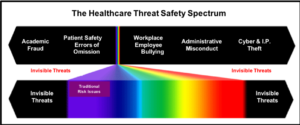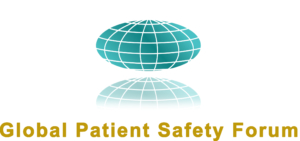Emerging Threats Community of Practice
A select group of leaders of top ranked medical centers and world-class subject matter experts are working together to address emerging threats. Emerging threats to those we serve, those who serve, and our property both physical and virtual. Those we serve are our patients and their families. Those who serve are caregivers, professional administrators, researchers, and staff. Our property is both real and virtual including intellectual property, data, and our reputations. The video below provides a summary of the strategies and tactics of the group.

The private community of practice addresses a number of sensitive topics and subject matter that should not be made public for security reasons.
- Brand Damage from Outside, Inside, and or Mixed Outside-Inside Threats including cyberterrorism.
- Workplace Violence including physical, verbal, sexual, or emotional harassment, bullying or harm to caregivers, staff, students, or patients.
- Active Shooter, Violent Intruder, and Deadly Force Incidents including events causing physical harm to staff, caregivers, students, or patients.
- Domestic Terrorism such as organized attacks using chemical, biologic, radiologic, nuclear, and explosive weapons as well as weaponization of transportation & vehicles (CBRNET)
- Violent Acts Against Leadership where administrative, clinical, or governance leaders are specifically targeted by insiders or outsiders.
- Intentional Harm of Patients by caregivers who commit harmful acts against patients with or without enablers who do not report such harm.
- Unintentional Patient Harm through errors of omission from systems failures such as those identified by mortality reviews including diagnostic errors or NQF Never Events.
- Failure to Rescue in pre-hospital, hospital, and post-hospital continuity of care.
- Preventable Death or Severe Injury of staff or students on or off campus or site.
- Financial Harm to patient families by aggressive payment policies and actions.
- Hospital Optimization & Flow with overcrowding & boarding/transfer issues.
- Readiness for Epidemics including preparedness for volume care need surges.
- Sexual Misconduct including sexual harassment, abuse of power, and or harm to caregivers, staff, students, or patients.
- Racial and or Sexual Discrimination against those we serve including patients and their families and or those who serve in the organization.
- Cybersecurity Patient Records Issues including breach, theft, and contamination of medical records leading to patient and caregiver harm.
- Cybersecurity Operation Issues including breach, theft, and contamination of operational records, invasion of data systems, and ransom crimes.
- Insider Threats of intentional clinical, operational, or financial harm.
- Theft of Intellectual Property by insiders, outsiders, or nation-states.
- Sabotage of service, information systems, clinical care, and property.
- Employee Fraud including false identity/credentials, testing/vaccinations, attestations of truth, or false witness against patients or staff.
- Patient Fraud including false identity, testing/vaccinations, attestations of truth, or false witness against other patients or staff.
- Nation State Influence through academic espionage, financial conflicts of interest, or other means.
- Drug Diversion by staff including caregivers and pharmacists who divert medications for themselves or others.
- Conflict of Interest of governance, staff, physicians, researchers, or administrators including undisclosed as well as disclosed financial relationships.
- Contamination of Food, Water, Air, and Spaces; by pollutants such as microplastics, chemicals, and biological contaminants.
- Academic Fraud including fabrication, falsification, or plagiarism in publications or dishonest grant documentation including applications or reports.
- Defamation or Unfair Press by investigative reporting, false whistleblowers, or harm due to misinformation, disinformation, or mal-information publicized.
- Burn-out of caregivers, leadership, and staff.
- Critical Drug and Supply Shortages such as I.V. fluids, medications, and key supplies.
- Regulatory Compliance Issues including evolving risks of non-compliance.
